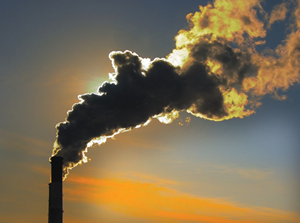Acid Rain Program
On this page:
Overview

The Acid Rain Program (ARP), established under Title IV of the 1990 Clean Air Act (CAA) Amendments requires major emission reductions of sulfur dioxide (SO2) and nitrogen oxides (NOx), the primary precursors of acid rain, from the power sector. The SO2 program sets a permanent cap on the total amount of SO2 that may be emitted by electric generating units (EGUs) in the contiguous United States. The program was phased in, with the final 2010 SO2 cap set at 8.95 million tons, a level of about one-half of the emissions from the power sector in 1980. NOx reductions under the ARP are achieved through a program that applies to a subset of coal-fired EGUs and is closer to a traditional, rate-based regulatory system. Since the program began in 1995, the ARP has achieved significant emission reductions. See our annual progress reports for more information on the progress of the ARP.
The ARP was the first national cap and trade program in the country and it introduced a system of allowance trading that uses market-based incentives to reduce pollution. Reducing emissions using a market-based system provides regulated sources with the flexibility to select the most cost-effective approach to reduce emissions, and has proven to be a highly effective way to achieve emission reductions, meet environmental goals, and improve human health.
Learn more about:
- Acid Rain Program Results
- Clean Air Markets Progress Report
- Allowances and allowance trading
- Continuous Emissions Monitoring systems and emissions monitoring
- Emissions and allowance data collected
Additional Reading
The following links exit the site Exit
- Plain English Guide to the Clean Air Act
- Lessons Learned from Three Decades of Experience with Cap-and-Trade (PDF)(November 2015)
- The SO2 Allowance Trading System and the Clean Air Act Amendments of 1990: Reflections on Twenty Years of Policy Innovation (PDF)(January 2012)
SO2 Reductions

Title IV of the Clean Air Act set a goal of reducing annual SO2 emissions by 10 million tons below 1980 levels by means of a two-phase cap and trade program for fossil fuel-fired power plants:
- Phase I (began in 1995)
Affected 263 units at 110 mostly coal-burning electric utility plants located in 21 eastern and midwestern states. An additional 182 units joined Phase I of the program as substitution or compensating units, bringing the total number of Phase I affected units to 445. - Phase II (began in 2000)
Added more units to the Acid Rain Program, which with Phase II encompasses over 2,000 units in all. Units that were included for the first time in Phase II included smaller units fired by coal, oil, and gas. The program affects utility units serving generators with an output capacity of greater than 25 megawatts and all new utility units.
Reductions in SO2 emissions are facilitated through a market-based cap and trade system. The allowance trading system includes low-cost rules of exchange that tailor EPA's administrative role and facilitate allowance trading as a viable compliance strategy for reducing SO2.
Under this system, EPA sets a cap on overall emissions. SO2 allowances are then allocated to affected units serving generators greater than 25 megawatts. All new units based on their historic fuel consumption and specific emission rates. Each allowance permits a unit to emit one ton of SO2.
Sources may choose among several options to reduce emissions. Sources may sell or bank (save) excess allowances if they reduce emissions and have more than they need, or purchase allowances if they are unable to keep emissions below their allocated level. At the end of the year, each source must hold sufficient allowances to cover its SO2 emissions (each allowance represents one ton of emissions).
NOx Reductions

The Acid Rain Program called for a two million ton reduction in NOx emissions below 1980 levels by 2000. A significant portion of these reductions have been achieved by coal-fired utility boilers that have installed low-NOx burner technologies.
As with the SO2 emission reduction requirements, the NOx program was implemented in two phases, beginning in 1996 and 2000:
- Phase I ran from 1996 to 1999 and covered Group 1 Boilers.
- Phase II began in 2000 and covers Group 1 and Group 2 Boilers
(For definitions of the types of boilers covered under the phases of the ARP, visit NOx Reductions under Phase II)
The NOx program embodies many of the same principles of the SO2 trading program, in that it also has a results-oriented approach, flexibility in the method to achieve emission reductions, and program integrity through measurement of the emissions. However, it does not "cap" NOx emissions as the SO2 program does, nor does it utilize an allowance trading system.
Applicability Determinations
An applicability determination is a formal EPA response to questions about how regulations apply to a particular situation. Below are EPA's responses to written requests for applicability determinations under 40 CFR 72.6. They illustrate the facts EPA considers when deciding how Acid Rain Program regulations (codified at 40 CFR 72.6) apply. The references after each description highlight the key provisions applied in each response. Each determination is based on application of 40 CFR 72.6 to the specific facts in each case and may not apply to other cases.
- Acid Rain Program 1994 Applicability Determinations
- Acid Rain Program 1995 Applicability Determinations
- Acid Rain Program 1996 Applicability Determinations
- Acid Rain Program 1997 Applicability Determinations
- Acid Rain Program 1998 Applicability Determinations
- Acid Rain Program 1999 Applicability Determinations
- Acid Rain Program 2000 Applicability Determinations
- Acid Rain Program 2001 Applicability Determinations
- Acid Rain Program 2002 Applicability Determinations
- Acid Rain Program 2003 Applicability Determinations
- Acid Rain Program 2004 Applicability Determinations
- Acid Rain Program 2006 Applicability Determinations
- Acid Rain Program 2008 Applicability Determinations
- Acid Rain Program 2009 Applicability Determinations
- Acid Rain Program 2011 Applicability Determinations
Next, learn more about the results of the Acid Rain Program.
Or, learn more about:
